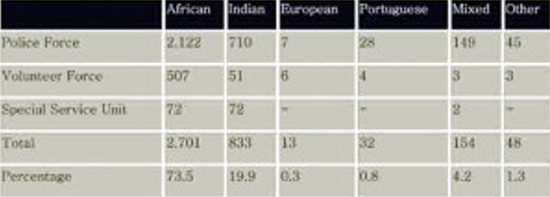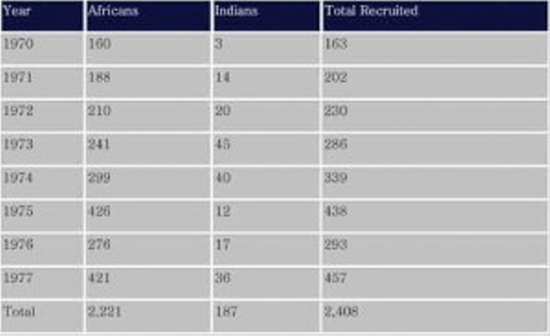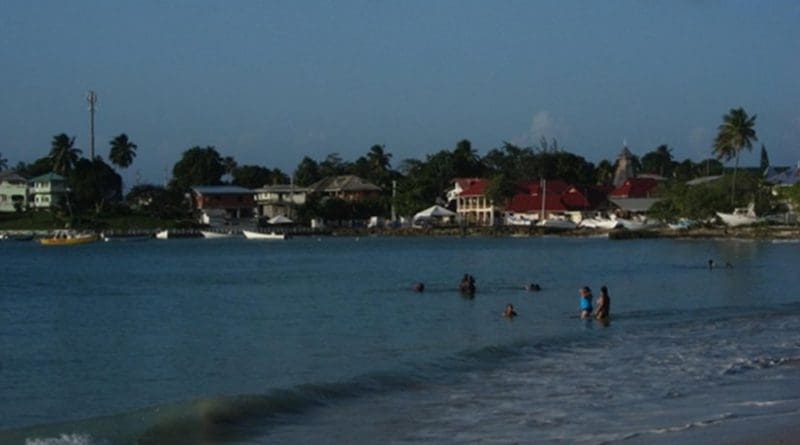Ethnicity And Security Forces In Guyana And Trinidad & Tobago – Analysis
By Manohar Parrikar Institute for Defence Studies and Analyses (MP-IDSA)
By Sanjay Badri-Maharaj
The year 2015 was an eventful one in the politics of both Guyana and Trinidad & Tobago where incumbent governments were defeated in elections held in May and September 2015, respectively. In both instances, governments led by people of Indian descent – Donald Ramotar in Guyana and Kamla Persad-Bissessar in Trinidad – were defeated by parties or alliances led by people of African descent, David Granger in Guyana and Keith Rowley in Trinidad. The transition of power was peaceful and no aspersions can be cast upon the electoral process in either country. However, it is interesting that despite people of Indian descent forming the largest ethnic group in both Guyana (43.5 per cent of the population) and Trinidad (35.4 per cent of the population), parties dominated or led by Indians were unable to retain power, suggesting that factors other than or in addition to ethnicity determined the electoral outcome.
Of greater interest perhaps is the fact that in both Guyana and Trinidad, the security forces have been dominated by people of African origin and, despite periods of governments led by ethnic Indians, this pattern has not changed. It is tempting to draw similarities between the two countries in this regard, but that would be completely erroneous. While there has been a pattern of discriminatory practices in Guyana during much of the 1970s and 1980s, the same cannot be said of Trinidad where, despite some degree of racial tension, the security forces have no such record of discrimination although isolated incidents have occurred. When figures are examined, the percentage of persons of Indian descent in the security forces of the two countries is disproportionately low compared with their population. This does not augur well for the political discourse on the subject as perceptions of continuing discrimination may be discouraging applicants who presume that they will not be accepted into service.
Guyana
In May 2004, Guyana’s Disciplined Forces Commission submitted its final report, a year after it was constituted. The Commission’s report dealt with, inter alia, measures to increase the efficacy of the Disciplined Forces as well as addressing the ethnic imbalance issue that has long plagued the Guyanese protective services. Of particular interest were the details released on the ethnic composition of the Guyana Defence Force (GDF) and the Guyana Police Force (GPF). In testimony before the Commission, the GDF indicated that it had, in 2003, an actual strength of some 2630 personnel – 20 short of its authorised strength. Of these 80 per cent were Afro-Guyanese, eight per cent Indo-Guyanese and 12 per cent other races.1
The GPF was considerably less forthcoming with raw data about its composition and the Commission was forced to accept an observation that the 2750 strong GPF seemed to have a ratio of one Indo-Guyanese officer to five non-Indo-Guyanese.2
If this data is accurate, and there is no indication to the contrary, then there has been a marked deterioration in the representation of Indo-Guyanese in the GDF and GPF. The facts disclosed reveal a situation that is even worse than that which existed in 1965. In 1965, the International Commission of Jurists conducted an inquiry in which, among other things, the question of racial balance in the security forces was addressed. Their findings, especially in light of the data disclosed above, make for sobering reading and indicate that Indians made up only 19.9 per cent of the total security forces3:
The data disclosed to the Disciplined Forces Commission seems to indicate that the years of rule by the Afro-Guyanese dominated government, which lasted between 1964 and 1992, intensified a pattern of de facto exclusion of Indo-Guyanese from the protective services. The GPF in particular seems to have suffered heavily in this regard as its Indo-Guyanese component fell from 23 per cent in 1965 to less than 17 per cent at present. The data for the GDF would seem to indicate that enlistment patterns have remained substantially the same for the last several decades. It is possible to overlook the fact that the aforementioned figure of 17 per cent may actually represent a substantial improvement in the ethnic composition of the GPF as a study of empirical recruiting data by G.K. Danns between the years 1970 and 1977 shows that fewer than 7.8 per cent of the recruits during that period were Indo-Guyanese, this perhaps being a consequence of a deliberate policy of biased recruiting4.
There have been recent signs that more Indo-Guyanese are coming forward to join the GPF, with anecdotal evidence suggesting that near parity in recruiting numbers has been achieved on occasion. The Disciplined Forces Commission was not in favour of racial quotas in recruitment, calling them “constitutionally offensive”, but nonetheless supported moves towards greater inclusivity and establishment of an effective grievance redress mechanism for Indo-Guyanese recruits and officers who may feel unfairly targeted on racial grounds.5 The increased proportion of Indo-Guyanese recruits, however, gives the lie to the assertion of a lack of willingness on the part of Indo-Guyanese to join the GPF. While there is no direct linkage between the ouster of the PNC from power in 1992 and an improved ethnic balance in the security forces, it would appear that the PPP Government has been supportive of a much more inclusive and racially balanced recruiting policy than its rival.
The GDF presents a somewhat different scenario, with Indo-Guyanese representation therein remaining static for a considerable period of time. To its credit, the GDF very openly stated to the Commission that it recognized that the question of ethnic balance is an issue that needs to be addressed, and admitted that its policy, allowing all ethnic groups to join its ranks, is not well known and should be widely advertised as part of the GDF’s commitment to inclusive recruitment.
Such admissions are undoubtedly to be commended, but it remains to be seen whether or not the GDF will take the initiative in facilitating a change in perception among Indo-Guyanese, thus perhaps enabling greater enlistment from that group. This assumes significance following the electoral defeat of Donald Ramotar and it is still a question as to whether the new administration will be favourably disposed towards such an agenda.
Trinidad & Tobago
Any concerns that may exist about the racial composition of the Trinidad and Tobago Police Service (TTPS) are born out of the fear that they could become instruments of ethnic repression rather than on any tangible evidence of any such tendencies. At no point in time has either the TTPS or the Trinidad and Tobago Defence Force (TTDF) shown any inclination in this regard. Unfortunately, however, discussions on racial issues in the country often leads to arguments and accusations rather than reasoned debate, and an attempt to raise the issue regarding the issue of promotions in TTPS led to the dismissal in 2011 of the head of the Police Service Commission, Mr. Nizam Mohammed. It is this immaturity that has masked some tangible progress made by the TTPS and has also served to conceal some areas of possible concern.
Indo-Trinidadians have traditionally been significantly better represented in the TTPS than in the TTDF. As of 14 September 1992, the TTPS had an Indo-Trinidadian component of 24.67 per cent.6 However, the proportion of Indo-Trinidadians decreases substantially above the rank of corporal. This trend has unfortunately continued, with data from 2010 revealing that there were no Indo-Trinidadians above the rank of Superintendent. This was despite Indo-Trinidadians now comprising 1917 of the 6219 strong TTPS, i.e., 30.82 per cent of the force.7 There are serious concerns regarding the fairness of the promotions process, with the suggestion being made that a certain degree of racial discrimination exists at the promotion stage. A recommendation to abolish the Promotion Advisory Board of the TTPS has not been implemented to date.8 Such discrimination, if proven, is clearly unacceptable and needs to be investigated without delay.
The situation in the TTDF is rather different. Indeed, there are signs that the ethnic imbalance – never good at the best of times – has dramatically worsened since 1992. It must be stated, however, that it is very unclear whether this is as a result of racial discrimination and any suggestion to that effect is perhaps premature. In 1992, the TTDF comprised of the Trinidad and Tobago Regiment (TTR) and the Trinidad and Tobago Coast Guard (TTCG). In that year, the ethnic balance of the security forces was as follows:9
| Service | Percentage of Indo-Trindadians |
| Trinidad and Tobago Police Service (TTPS) | 24.67% |
| Trinidad and Tobago Regiment (TTR) | 10.12% |
| Trinidad and Tobago Coast Guard (TTCS) | 24.67% |
Since then, the TTDF has been substantially expanded in size – more than doubling in the case of the TTR (to brigade size with four battalions and 2900 personnel), the TTCG increasing to over 1300 personnel, and the formation of a small independent air wing, the Trinidad and Tobago Air Guard TTAG, with 196 personnel in 2005. However, by 2011 the ethnic composition of the TTDF had shown a marked deterioration contrasting with the improved figures of the TTPS:10
| Service | Percentage of Indo-Trindadians |
| Trinidad and Tobago Police Service (TTPS) | 30.8% |
| Trinidad and Tobago Regiment (TTR) | 5.7% |
| Trinidad and Tobago Coast Guard (TTCS) | 7.6% |
| Trinidad and Tobago Air Guard (TTAG) | 11.2% |
This apparent deterioration in the proportion of Indo-Trinidadians in the TTDF may be at least partially due to the overstating of the 1992 data by the inadvertent inclusion of mixed-race personnel in the data for Indo-Trinidadians. Nonetheless, the decline should be a cause for concern as, while the TTDF asserts with justification that it does not discriminate against Indo-Trinidadians, there is a perception that the TTDF does not want Indo-Trinidadian recruits and that, during the course of training, Indo-Trinidadian recruits are singled out for racial abuse by Afro-Trinidadian recruits and NCOs. There is some evidence to suggest that such abuse may indeed occur, but such instances are rare exceptions rather than the norm. There seem, however, to be few bars to promotion within the TTDF as both the TTR and TTCG have had Indo-Trinidadian Commanding Officers and until 2015 the Chief of Defence Staff was also Indo-Trinidadian.
There is also a general reluctance among Indo-Trinidadians to enlist in the TTDF, partly because of better career opportunities elsewhere, but also because of a complete lack of awareness of the career options available in the TTDF. So thorough is the disconnect between TTDF recruiting efforts and the Indo-Trinidadian community, that few among the latter even know when recruiting takes place. With no military presence in Indo-Trinidadian dominated areas, members of the community are not exposed to the military and as a result few have any interest in enlisting. This state of affairs is not satisfactory as a disproportionate share of Trinidad’s skilled and educated manpower is thus effectively excluded from TTDF selection.
Conclusion
The contrasting stories of the security forces in Guyana and Trinidad & Tobago offer some lessons to anyone looking at the issue of ethnicity and armed forces. For diverse reasons, people of Indian descent are underrepresented, quite substantially, in the security forces of both countries. What both nations have in common, however, is that perception looms larger than reality and it is this perception of discrimination and the attendant reluctance of Indo-Trinidadians and Indo-Guyanese to enlist in proportionate numbers that gives rise to a circle of claims of discrimination that never augur well for good race relations.
Views expressed are of the author and do not necessarily reflect the views of the IDSA or of the Government of India. Originally published by Institute for Defence Studies and Analyses (www.idsa.in) at http://idsa.in/idsacomments/ethnicity-security-forces-in-guyana-and-trinidad_sbmaharaj_050916
- 1. Unofficial pdf copy of the Disciplined Forces Commission Report, May 2004 (obtained by the author), p.196.
- 2. Ibid, p. 89.
- 3. “Racial Problems in the Public Service,” Report of the British Guiana Commission of Inquiry Constituted by the International Commission of Jurists, with note by Dr. Odeen Ishmael, October 1965, available at http://www.guyana.org/govt/icj_report.html, Accessed 1 September 2016.
- 4. G. K. Danns, Domination and Power in Guyana (New Brunswick: Transaction Books, 1982), pp.120-22.
- 5. Op. cit., Note 1, pp. 90-101.
- 6. S. Ryan & J. La Guerre, Ethnicity and Employment Practices in Trinidad and Tobago (St. Augustine: Centre for Ethnic Studies, 1993), p.160. It should be noted however, that this study did not adequately address the “mixed-race” phenomenon in Trinidad. It is likely that the Indo-Trinidadian percentage could have been somewhat lower. The 2011 figures at Note 7 make allowances for the mixed race component of the TTPS under a separate heading.
- 7. “Gibbs, Khan, Nizam talking for months on imbalance,” Trinidad Express, 3 April 2011, available at http://www.trinidadexpress.com/news/Gibbs__Khan__Nizam_talking_for_months_on_imbalance-119161194.html, Accessed 1 September 2016.
- 8. A. Javeed, “Disband Promotions Advisory Board,” Trinidad Guardian, 4 April 2011, available at http://www.guardian.co.tt/node/10070, Accessed 1 September 2016.
- 9. Op. cit. Note 6.
- 10. While the TTPS data is official, the information for the various branches of the TTDF is based on the author’s discussions with TTDF personnel who are conversant with the figures.

